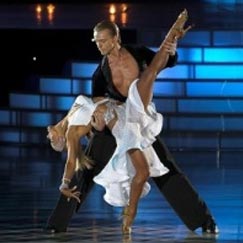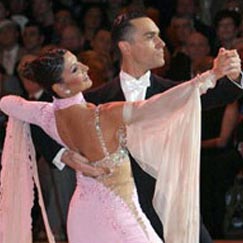What is Ballroom & Latin
A BIT OF HISTORY AND BASIC INFORMATION.
* Follow the link on each dance for more detailed info with video examples:
1. Tango
2. Pasodoble
DANCE IS A TYPE OF ART THAT GENERALLY INVOLVES MOVEMENT OF THE BODY, OFTEN RHYTHMIC AND TO MUSIC. IT IS PERFORMED IN MANY CULTURES AS A FORM OF EMOTIONAL EXPRESSION, SOCIAL INTERACTION, OR EXERCISE, IN A SPIRITUAL OR PERFORMANCE SETTING, AND IS sometimes used to express ideas or tell a story. Dance may also be regarded as a form of nonverbal communication between humans or other animals, as in bee dances and behaviour patterns such as a mating dances.
Ballroom dance is a set of partner dances, which are enjoyed both socially and competitively around the world. Because of its performance and entertainment aspects, ballroom dance is also widely enjoyed on stage, film, and television.
Ballroom dance may refer, at its widest, to almost any type of social dancing as recreation. However, with the emergence of dance sport in modern times, the term has become narrower in scope. It usually refers to the International Standard and International Latin style dances (see dance categories below). These styles were developed in England and are now regulated by the World Dance Council (WDC). In the United States, two additional variations are popular: American Smooth and American Rhythm.
There are also a number of historical dances , and local or national dances, which may be danced in ballrooms or salons. Sequence dancing, in pairs or other formations, is still a popular style of ballroom dance.
The word "ball" came from the Latin verb “ballare”, which means "to dance."
Ballroom dancing has a unique history, which was largely determined by their popularity as a recreational and competitive sport. Ballroom dancing, in the form as we know it today, originated in England in the late XVIII - early XIX century. During this period, the dances were a privilege of high society, an integral feature of grand balls. In the late XIX - early XX century, they became popular among the lower strata of society, who attended public dance halls or "public assembly". In the early 20-ies of this century ballroom dancing competitions were developed. In 1924, in England the Department of ballroom dancing was created at the Imperial Society of Teachers of Dance. Its task was to develop standards for the music, the steps and technique of ballroom dancing. Gradually, dance sport spread throughout Europe, Asia and also reached America.
Of all the partner dances , the most interesting in terms of emotional and rhythmic content of music, dance, in which you can create the most profound and interesting artistic image were selected dances for the competition.
Ballroom dancing is divided into two programs: the European (Standard or International Style) and Latin American (Latin).
In the Standard program contact between a man and a woman is closer and carried out both by the hand and the correct position of the body. It is maintained throughout the dance.
In the Latin American program contact is more free, and often at the expense joined hands, sometimes even generally lacking being amplified by supports and other shapes.
Latin American program
In the Latin American program of dance or Latina (Latin) there are 5 basic dances, namely the Samba, the Cha-Cha-Cha , the Rumba, the Paso Doble and the Jive. The order of dancing in the competition is as follows:
|
In the Amateurs Division: 1. Samba |
In the Professional Division: 1. Cha-cha-cha |
 Cha-cha-chaIn the famous Blackpool Dance Festival in Britain, dancing couples compete in all 5-Latin American dances.
Cha-cha-chaIn the famous Blackpool Dance Festival in Britain, dancing couples compete in all 5-Latin American dances.
Time signature: 4/4. Tempo: 30-32 bpm.
Exciting, syncopated Latin dance which originated in the 1950s as the slow Mambo. This dance was first seen in the dance halls of America. The Cha-Cha-Cha music should produce a happy, carefree and slightly crazy atmosphere. The Cha-Cha-Cha got its name from the special nature of the repeating basic rhythm and a specific instrument, the maracas. Recently, it was decided to shorten the name of this dance to the Cha-Cha .
Samba
Time Signature: 2/4. Tempo: 50-52 bpm.
Until 1914 this dance was known as the Brazilian title "Maxixe". The first attempts to introduce Samba in the European dance halls belong to the years 1923-24, but only after the Second World War, did the Samba become a popular dance in Europe. Samba has a very distinctive rhythm, which is highlighted by his best (I do not know what you mean) to meet the national Brazilian musical instruments. Initially it (what do you mean by "it?) was called tamborim, chocalho, reco-reco and cabaca. Samba , the Brazilian national rhythmic dance has now confidently entered the program of contemporary ballroom dance. The Samba includes typical Latin hip movements, which are known as the "Samba Bounce" springy movements.
Rumba
Time signature: 4/4. Tempo: 25-27 bpm.
Rumba – A Cuban couple dance of African origin. The distinctive features of the rumba are sexy smooth moves, coupled with long strides, sensual, full of love, movements and gestures. A Latin American style movement in the hips, is an interpretation of the relationship between a man and a woman. The most well-known all over the world rumba tunes can be considered as the famous «Besame Mucho» written by Consuelo Velasquez at the age of 16 and «Guantanamera» by Joseite Fernandez. These melodies have quickly become a classic rumba.
Pasodoble
Time Signature: 2/4. Tempo: 60-62 bpm.
Dance of the Spanish Gypsies. The dramatic French-Spanish Flamenco-style march, which depicts a man toreodor (brave man) fighting with a bull. The lady is a femme fatale Carmen, second matador or his cape, depending on the circumstances. In the Pasodoble choreographers focus on creating a body shape typical to a matador with the addition of Flamenco dance movements in the hands, elbows, wrists and fingers. Feet, or rather heels are used to create the correct rhythmic interpretation.
Jive
Time signature: 4/4. Tempo: 42-44 bpm.
Jive - International Version of the Swing dance. Today the Jive is performed in several styles: International and swing, and very often a combination of both in a variety of shapes. Dances such as the Rock-n-Roll, the Lindy Hop and the Jitterbug have a very strong influence on Jive. The Jive is sometimes referred to as a six-step Rock'n'Roll. It is very fast and consumes a lot of energy dance. This is the last dance that danced in the competition, and the dancers have to show that they are not tired and ready to execute it efficiently.
The European Program
The european dance program or standard is composed of 5 basic dances namely the Slow Waltz (Slow or English Waltz), the Slow Foxtrot, the Tango, the Fast Foxtrot or Quickstep and the Viennese Waltz . The order of dancing in the competition:
|
In the Amateurs Division: 1. Slow Waltz |
In the Professionals Division: 1. Slow Waltz |
 The famous Blackpool Dance Festival in Britain, dancing couples compete only in 4 dances of the European program. The exception is the Viennese Waltz. However, they exercise all the dancing duets before the competition, "getting acquainted" with the parquet.
The famous Blackpool Dance Festival in Britain, dancing couples compete only in 4 dances of the European program. The exception is the Viennese Waltz. However, they exercise all the dancing duets before the competition, "getting acquainted" with the parquet.
Viennese Waltz
Time signature: 3/4. Tempo: 58-60 bpm.
The first Viennese Waltz dated 12 - 13 century and used in a dance called "Nachtanz". The Viennese Waltz came to us from Bavaria, and was then called as "German". In another version, the Waltz is a dance of French peasants. Around the beginning of 1830, the composers Franz Lanner and Johann Strauss wrote some very famous waltzes of all the times, thus contributing to the development and popularity of the dance. These waltzes were very fast, but making the rhythm of the dance more convenient. We now call them the Viennese Waltz and always dance it with happiness.
Slow Waltz
Time signature: 3/4. Tempo: 28-30 bpm.
The Waltz was brought to the United States in the mid 1800s. The Viennese waltz tempo was too fast, and soon the composers began to write music that was much slower. This music has evolved a new style of Waltz called “Boston”, with slow turns, and a long, sliding motion. Approximately in 1874, in England, the influential "Boston Club" was formed and a new style of dance began to appear, which later was named the Slow Waltz. However, only after 1922 did the dance become as fashionable as the Tango. Interesting, but what used to be Waltz in that period is very different from what we are doing now. Immediately after the first World War, the Waltz changed rapidly. In 1921 it was decided that the basic movement should be: step, step, close. When in 1922 Victor Sylvester won the championship, the English waltz program consisted of only a right turn, a left turn and a change of direction. In 1926/1927 Waltz was greatly improved. The main motion was changed to: step, step to the side, close. As a result, there were more opportunities for the development of figures. They have been standardized by the Imperial Society of Teachers of Dancing (ISTD). Many of these, we still dance.
Tango
Time signature: 2/4. Tempo: 31-33 bpm.
The Tango was first performed in Europe before the first World War, at the rate of 36 beats per minute. It came from Buenos Aires (Argentina), where it was performed for the first time in "Barria Las Ranas", the ghettos of Buenos Aires. It was then known under the name of "Baile con corte" (dance with the rest). "Dandy" of Buenos Aires changed the dance in two ways. First they changed the so-called "Polka rhythm" to the "Habanera rhythm", and secondly, they called the dance Tango.
Slow Foxtrot
Time signature: 4/4. Tempo: 28-30 bpm.
The Foxtrot dance that was born in the twentieth century and was named in honor of the American artist Harry Fox (Harry Fox). Originally, it was performed at a tempo 48 beats per minute. The problem that led to the two directions of the Foxtrot was its tempo. The the Quickstep or Fast Foxtrot was danced with the music that was played at a speed of about 50 - 52 beats per minute , and the Slow Foxtrot with music that was played at a tempo of 32 beats per minute. The charming Foxtrot has an image of a dance created for high society.
Quickstep
Time signature: 4/4. Tempo: 50-52 bpm.
This dance appeared during the First World War, in the suburbs of New York, originally sung by African dancers. It made its debut at the American Music Hall and became very popular in dance halls. Foxtrot and Quickstep have a common background. In the twenties many bands played Slow Foxtrot too fast, which caused many complaints among the dancers. In the end, two different dances developed, the tempo was slowed down to 29-30 beats per minute for the Foxtrot, and the Quickstep, which became the fastest version of Foxtrot, was executed at a tempo of 48-52 beats per minute. One of the dances that influenced the development of the Quickstep was the popular Charleston.


